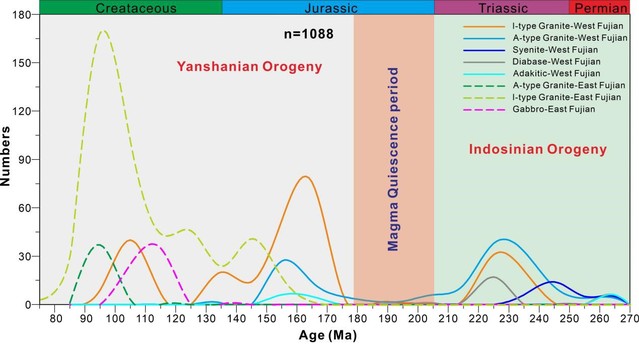Yalong Lia, b, Xun Yua, Huichuan Liuc, Xiangtong Huanga, Wei Yued, Ergang Liana, Shouye Yanga*
a State Key Laboratory of Marine Geology, Tongji University, Shanghai, China
b School of Environmental and Geographical Sciences, Shanghai Normal University, Shanghai, China
c State Key Laboratory of Petroleum Resources and Prospecting, China University of Petroleum (Beijing), Beijing, China
d School of Geography, Geomatics and Planning, Jiangsu Normal University, Xuzhou, China
Abstract:
The Cathaysia Block is featured by intense tectonic activities and magmatic intrusions during the Mesozoic, and its geochemical evolution might greatly imprint the river sediment compositions in southeast China. This paper presents a comprehensive synthesis of data from petrology, U-Pb geochronology, and geochemistry of both river sediments and plutons in Fujian Province, and aims to reveal the constraints of Mesozoic geochemical heterogeneity and geochronology of the Northeast Cathaysia Block on local river sediment geochemistry. The Fujian terrane and relating river systems can be divided into western and eastern parts with the boundary of the Zhenghe-Dabu Fault. The sediments of eastern rivers are characterized by heavy minerals derived from granites and two major U-Pb age groups (90–110 Ma and 120–150 Ma) of detrital zircons. However, the sediments of western rivers are featured by heavy minerals from the Precambrian rocks and have seven zircon U-Pb age groups (from 90 Ma to 3.0 Ga). The Indonesian magmatic rocks predominantly originated from the Proterozoic crust, with less contribution from the depleted mantle, which are much different from the Yanshanian A-type granites and gabbros in the eastern terrane. We infer that the middle part of Zhenghe-Dabu Fault formed in the Jingningian Period primarily caused geochemical and geochronological heterogeneity of the Northeast Cathaysia Block, which further determined the totally different sediment compositions between the western and eastern Fujian rivers.
Full Article:https://www.sciencedirect.com/science/article/pii/S0341816223000012



